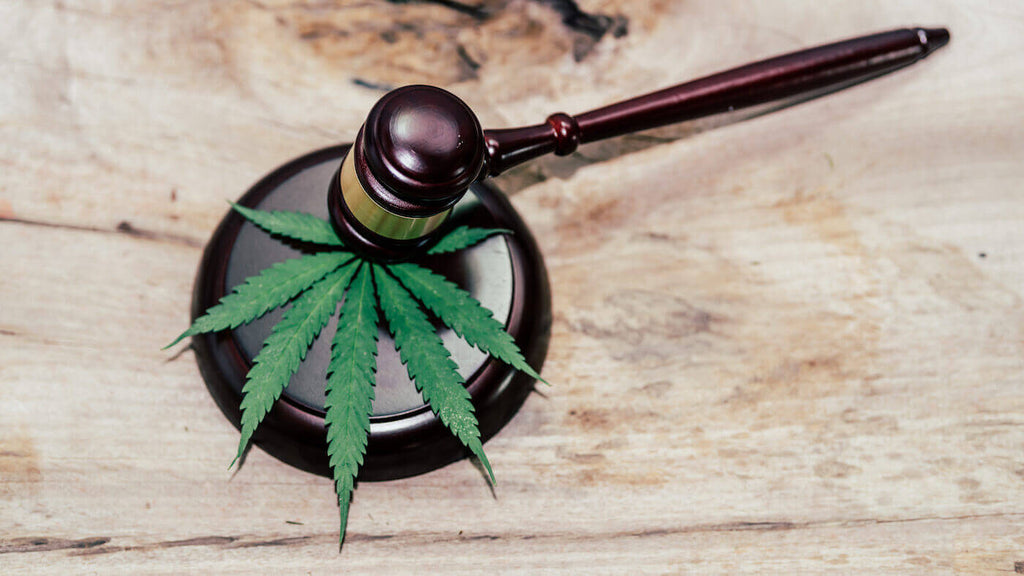
Before we start, here are some updates on marijuana as stated by the NSCL:
- As of February 3, 2022, 37 states and 4 territories have legalized the use of cannabis products for medical purposes.
- November 2020 brought an approved ballot proposal by Mississippi voters for medical marijuana use. However, the Supreme Court reversed it on May 14, 2021.
- As of November 29, 2021, 18 states, 2 territories, and the District of Columbia enacted legislation regulating cannabis for nonmedical use.
Table of Contents
- 1. What is medical marijuana?
- 2. Is medical marijuana legal in the US?
- 3. What are the state medical marijuana laws exactly?
- 4. What is medical marijuana used for?
- 5. What are the health effects of medical cannabis?
- 6. Is using cannabis-related to drug abuse?
- 7. What forms of medical cannabis are there?
- 8. Is there a stigma with using medical marijuana?
- 9. Is using medical cannabis dangerous?
- 10. How do you get medical marijuana?
Looking where to buy the best at home drug test? Look no further. Get yours on Amazon today!
1. What is medical marijuana?
Medical marijuana is the dried portions of the Cannabis sativa plant used for medical treatments. Cannabinoids are a group of over 200 compounds found in cannabis plants. Each has a unique impact on our bodies.
Delta-9-tetrahydrocannabinol THC (THC) and cannabidiol are two significant medicines. For generations, humans have used it as a herbal cure, and it is still used today to relieve symptoms and treat a variety of conditions.
For decades, clandestine marijuana farmers have been cross-breeding and choosing the highest-potency plants to produce more potent marijuana. The ingredient responsible for marijuana’s euphoric highs, delta-9-tetrahydrocannabinol (THC), was found in 4% of cannabis in 1995 and rose to 17% by 2017, according to research. And it doesn’t stop there!
In 2017 you could already find marijuana strains in dispensaries in Colorado that had THC levels of 17-28% and concentrates with 85 to 90% THC.
“This is not the marijuana people smoked in dorm rooms in the 1970s, you have to be careful.”
- Staci Gruber, Director of the Marijuana Investigations for Neuroscientific Discovery (MIND) program at Harvard-affiliated McLean Hospital in Belmont, Massachusetts
Fortunately, various products are available that are low in THC and high in cannabidiol, or CBD, the other key cannabis ingredient. Although federal law still deems medical cannabis illegal, certain states allow it to treat certain medical conditions.
2. Is medical marijuana legal in the US?

Even though every state has laws against the use of medical cannabis, more than two-thirds of states and the District of Columbia have legalized marijuana for medical use. They plan that congress will also pass bills to legalize it across the US.
However, the FDA has only approved medical cannabis for two rare and severe forms of epilepsy, Dravet syndrome and Lennox-Gastaut syndrome. In addition, the FDA approved two manufactured cannabinoid medicines (dronabinol and nabilone) to treat nausea and vomiting from chemotherapy.
Marijuana is illegal in the United States by federal law, but many states permit medical marijuana to relieve pain, nausea, and other symptoms.
The feds, however, are reluctant to enforce the prohibition in the face of mounting support by states. Thirty-three states (plus the District of Columbia, Guam, Puerto Rico, and the US Virgin Islands) permit medical cannabis for qualifying patients; a doctor’s certification and patient card are generally required.
State laws differ on such critical questions as who can grow it, who can sell medical cannabis, and what medical condition it can qualify to be used for.
Note: If you are being treated with medical cannabis, make sure your future employer knows about your treatment. The reason is they might ask you to take an employment drug test before or during your work.
3. What are the state medical marijuana laws exactly?
According to the NCSL, the medical marijuana plant is legal in 37 states and the District of Columbia:
- Alaska
- Alabama
- Arizona
- Arkansas
- California
- Colorado
- Connecticut
- Delaware
- District of Columbia
- Florida
- Hawaii
- Illinois
- Louisiana
- Maine
- Maryland
- Massachusetts
- Michigan
- Minnesota
- Missouri
- Montana
- Nevada
- New Hampshire
- New Jersey
- New Mexico
- New York
- North Dakota
- Ohio
- Oklahoma
- Oregon
- Pennsylvania
- Rhode Island
- South Dakota
- Utah
- Vermont
- Virginia
- Washington
- West Virginia
Furthermore, states with rules on restricted use include Georgia, Indiana, Iowa, Kansas, Kentucky, Mississippi, North Carolina, South Carolina, Tennessee, Texas, Wisconsin, and Wyoming.
Federal law regulating marijuana supersedes state laws. Because of this, people may be arrested and charged with possession even in states where marijuana use is legal. Always be aware of the local rules about marijuana, whether it’s for medical purposes or recreational use.
Note: Marijuana can also create CBD, a significant legal ambiguity. Purified CBD derived from hemp plants is permitted in the United States; however, it is illegal if derived from marijuana plants. The reason for this is that the DEA has made marijuana plants illegal.
4. What is medical marijuana used for?

According to research, medical cannabis is not proven to relieve pain or muscle spasms, but it is known for muscle spasms. Also, researchers found that it was helpful in:
- Reducing nausea and vomiting during chemotherapy treatment.
- Minimizing pain symptoms for adults with chronic pain.
- Improving multiple sclerosis-related spasticities with short-term use of oral cannabinoids.
They add that medical cannabis can help improve the symptoms mentioned above. However, there’s still more research and information needed to assess their effects properly for other conditions.
They concluded that “there is no or insufficient evidence to support the conclusion that cannabinoids are an effective treatment for achieving abstinence in the use of addictive substances.”
5. What are the health effects of medical cannabis?
Research that evaluated 321 articles to study the adverse effects of medical cannabis resulted in the following evaluation of severe side effects:
- Multiple sclerosis (12.8%)
- Vomiting (9.8%)
- Urinary Tract Infection (9.1%)
These numbers are counted from 4,779 side effects that the study gathered amongst participants. 96.6% (so 4,615) reported side effects were not serious. The most common “non-serious” side effect was dizziness.
6. Is using cannabis-related to drug abuse?
When medical cannabis was first introduced, researchers predicted that combining it with prescription treatments would increase alcohol and drug usage.
According to a new study published in the National Library of Medicine, patients who use marijuana and prescription opioids are not at an elevated risk of alcohol and drug misuse,
The study looked at data from 273 individuals (average age of 40) in a Michigan medical marijuana clinic.
Over 60% of the patients said they had used prescription pain relievers within the previous month. According to researcher Perron, this phenomenon hasn’t been researched extensively, but the results astonished him and his colleagues.
“Although persons who received both medical cannabis and prescription opioids reported higher levels of pain, they showed very few differences in their use of alcohol and other street drugs compared with those receiving medical cannabis only,” he said.
Though many people use marijuana for medical purposes, you should look at the THC content level as it may be higher than you expect.
Another study discovered that the majority of the goods sold in the medical dispensaries had more than 10% THC, with several containing 15% or more - the same amount as those sold in recreational dispensaries.
This is important because 60 to 80% of people who use medical cannabis do so for pain treatment. However, the higher the THC dosage, the greater the chance of developing dependency and tolerance, resulting in patients needing higher concentrations of THC to get the same level of pain relief.
7. What forms of medical cannabis are there?

There are quite a few methods to take medical cannabis. You can use it in:
- Vaporizers
- Patches
- Bongs
- Pills
- Tincture
- Spray
The frequency with which you should use each type, how they’ll improve your symptoms, and any adverse effects you might have are all different.
8. Is there a stigma with using medical marijuana?
Yes, there is, and for several reasons. For example, one study from the University of British Columbia found that medical cannabis users have been characterized as reckless and untrustworthy ‘potheads’ by various groups, including employers, coworkers, and even healthcare providers.
These misconceptions are far from the truth. That’s because many people with mental health concerns, including professionals, blue-collar employees, retirees, parents, and military veterans, use cannabis for therapeutic purposes.
Another study claims that the stigmatization of cannabis, including medical cannabis, may be due to the differences in global policies.
In summary, the stigmas and preconceptions about cannabis users obscure the truth that people from all areas of life are now taking medical cannabis for therapeutic purposes.
9. Is using medical cannabis dangerous?
It depends. Cannabis can:
- Acutely impair memory, judgment, and driving ability.
- Increase the risk of car accidents.
- Slowly become a habit leading to unhealthy use.
- Lead to chronic breathing problems when smoked over time.
Also, using cannabis apart from medical reasons during adolescence can cause health problems like respiratory illness, psychotic symptoms, etc., later on in life.
Medical cannabis use before, during, and after pregnancy may be associated with several health risks for you and your fetus.
Even if marijuana is legal where you live, you shouldn’t use it during pregnancy. Our patient FAQ’s have answers to several questions about marijuana and pregnancy: https:/www.acog.org/Patients/FAQs/Marijuana-and-Pregnancy pic.twitter.com/KHhpSamX4b
— ACOG (@acog) May 8, 2018
10. How do you get medical marijuana?
In locations where medical marijuana is permitted, you’ll need a written recommendation from a licensed doctor to get it (not every doctor is willing to recommend medical marijuana for their patients).
Also, you must have a medical condition that qualifies for medical marijuana use. Each state has its list of qualifying conditions, so make sure to check them first. Your state may also require you to get a medical marijuana ID card. Once you have that card, you can buy medical cannabis at dispensaries in your state.
To sum up
Whether you’re curious or are looking into using medical marijuana to treat pain, knowing the answer to the questions above will help you feel more relaxed and knowledgeable. Because otherwise, just using it for the sake of using it solves nothing. It’s better to go in whole-brained than absolutely clueless.
What’s one question we didn’t manage to answer about medical cannabis that’s still on your mind? Let us know in the comments below, and we'll make sure to get you the answer you need!
Resources:
- https://www.ncsl.org/
- https://pubmed.ncbi.nlm.nih.gov/
- https://www.ncbi.nlm.nih.gov/
- https://nida.nih.gov/
- https://www.aarp.org/
- https://www.epilepsy.com/
- https://www.webmd.com/
- https://www.mayoclinic.org/
- https://www.brookings.edu/
- https://www.europeanpharmaceuticalreview.com/
- https://harmreductionjournal.biomedcentral.com/
- https://journals.sagepub.com/
- https://www.acog.org/
- https://twitter.com/


9 comments
These are some really interesting facts, this is the first time I’m coming across any of these. Thanks for sharing this information.
I’ve never know about these truths about marijuana. That’s why it’s been prescribed to treat different respiratory problems.
Medical cannabis is very good. There is still a few things we have conclude about it before declaring it fully safe!
Ive always been curious about what exactly is Marijuana used for and how to get medical marijuana. Thanks for sharing this
Thanks for this. It was helpful for my research paper. I did not know that many states legalized the medical marijuana plant .